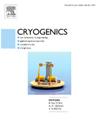Quantitative analysis of the impact of room temperature stability on cryostat performance
IF 1.8
3区 工程技术
Q3 PHYSICS, APPLIED
引用次数: 0
Abstract
The constant temperature in laboratories is crucial for precise low-temperature measurements. Currently, there are no reports on the specific temperature needs for such experiments or quantitative analyses of how room temperature fluctuations affect cryostat control. This paper proposes a method to quantitatively analyze these fluctuations and their impact on cryostat temperature control. Taking the cryostat using for 2 K-5 K thermodynamic temperature measurement as the research object, and conducts model simulation and experimental validation. The research results indicate the primary influence on the sphere’s temperature is the time-dependent fluctuation of the room temperature. As temperature fluctuations propagate from the cryostat’s outer casing to the sphere, heat conduction is the dominant factor. The temperature fluctuations inside the system caused by environmental temperature fluctuations can be quantitatively expressed by a simple linear formula, with the coefficient being the fluctuation attenuation rate, which is 6.590 × 10-4 in this system. The deviation between experimental results and simulation results is within 5 %. To keep the sphere’s ambient temperature influence below 0.077mK, or 20 % of cryocooler-induced fluctuations, the room temperature must be controlled within 0.12 °C. In addition, the fluctuation period of room temperature is controlled below 1 h, the 0th flange is thickened, the rod is lengthened, and the material of the rod is changed to G10 above 4.2 K and stainless steel below 4.2 K can also effectively attenuate the influence on system temperature control.
室温稳定性对低温恒温器性能影响的定量分析
实验室的恒温对于精确的低温测量至关重要。目前,还没有关于此类实验的具体温度需求或室温波动如何影响低温恒温器控制的定量分析报告。本文提出了一种定量分析这些波动及其对低温恒温器温度控制影响的方法。以用于 2 K-5 K 热力学温度测量的低温恒温器为研究对象,进行了模型模拟和实验验证。研究结果表明,对球体温度产生主要影响的是随时间变化的室温波动。当温度波动从低温恒温器外壳传播到球体时,热传导是主要因素。环境温度波动引起的系统内部温度波动可以用一个简单的线性公式来定量表示,其系数为波动衰减率,在本系统中为 6.590 × 10-4。实验结果与模拟结果的偏差在 5%以内。要使球体的环境温度影响低于 0.077mK,即低温冷却器引起波动的 20%,室温必须控制在 0.12 °C 以内。此外,将室温波动周期控制在 1 h 以下、加厚第 0 个法兰、加长杆件、将杆件材料在 4.2 K 以上改为 G10、在 4.2 K 以下改为不锈钢等措施也可有效减小对系统温度控制的影响。
本文章由计算机程序翻译,如有差异,请以英文原文为准。
求助全文
约1分钟内获得全文
求助全文
来源期刊

Cryogenics
物理-热力学
CiteScore
3.80
自引率
9.50%
发文量
0
审稿时长
2.1 months
期刊介绍:
Cryogenics is the world''s leading journal focusing on all aspects of cryoengineering and cryogenics. Papers published in Cryogenics cover a wide variety of subjects in low temperature engineering and research. Among the areas covered are:
- Applications of superconductivity: magnets, electronics, devices
- Superconductors and their properties
- Properties of materials: metals, alloys, composites, polymers, insulations
- New applications of cryogenic technology to processes, devices, machinery
- Refrigeration and liquefaction technology
- Thermodynamics
- Fluid properties and fluid mechanics
- Heat transfer
- Thermometry and measurement science
- Cryogenics in medicine
- Cryoelectronics
 求助内容:
求助内容: 应助结果提醒方式:
应助结果提醒方式:


